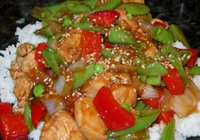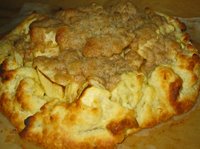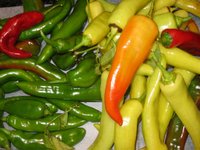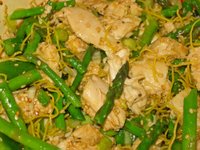We discovered how easy it was to grow ginger on a whim. We bought a big hunk at the grocery store our first year and stuck in in some dirt and put it in the hot bed with the grape seedlings in March. After the risk of frost, we moved it to the garden and mulched it. We never touched it until the first frost in the fall and then we dig it. It is wonderful fresh; like a new potato with a skin so thin you can scratch it off with your finger. Now we have enough to last until the next season. From about 10 plants in a typical year, you get about 30 pounds of ginger. This year was atypical so we only got about half that. It is truely easier to care for than anything else in the garden. If you haven't tried it, you will find it amazing. Ususally when we pull it, you can see the flower inforenceses forming, but it has never flowered. Even with starting indoors, the season is not long enough. We have grown it every year for more than 15 years and our friends look forward to the frost when we dig it all.

From The New Food Lover's Companion by Sharon Tyler Herbst:
ginger; gingerroot A plant from tropical and subtropical regions that’s grown for its gnarled lumpy root. Most ginger comes from Jamaica, followed by India, Africa and China. Gingerroot's name comes from the Sanskrit word for "horn root," undoubtedly referring to its knobby appearance. It has a tan skin and a flesh that ranges in color from pale greenish yellow to ivory. The flavor is peppery and slightly sweet, while the aroma is pungent and spicy. This extremely versatile root has long been a mainstay in Asian and Indian cooking and found its way early on into European foods as well. The Chinese, Japanese and East Indians use fresh gingerroot in a variety of forms-grated, ground and slivered-in many savory dishes. Europeans and most Americans {not this one} however, are most likely to use the dried ground form of ginger, usually in baked goods. Fresh ginger is available in two forms - young and mature. Young ginger, sometimes called spring ginger {I would have to call it fall ginger}, has a pale, thin skin that requires no peeling {see, I told you}. It is very tender and has a milder flavor than its mature form. Young ginger can be found in most Asian markets during the springtime. {We have never seen it for sale as tender as the ones we grow, even in the Asian markets}.
The New Food Lover's Companion goes on discussing how to preserve and discusses ground, ginger juice, candied ginger, preserved ginger, pickled ginger {which I make in the years when we really get a lot, not this year, though} and red candied ginger. There are separate definitions for ginger ale and ginger beer. They don't mention ginger tea, and that it very good.
We used it to make egg rolls to go with the hot and sour soup made with fresh wood ear mushrooms and fresh shitakes. We only see the fresh wood ears a few times a year fresh and can't pass them by. I have posted how to make egg rolls before, probably the last time we saw them. This is a current picture, but it looks the same. I guess we are creatures of habit.

Have you tried ginger ice cream? It is so good. If we weren't trying to lose wait......so instead we tried ginger yogurt as a healthy alternative. It's got the creamy hot spicy thing going on.
We also do quick stir fries when we time is limited. It is quick and easy and good too!

This is being submitted to
Weekend Herb Blogging hosted this week by Nandita of
Saffron Trail. Check it out Monday after she posts the roundup! Also, check out our website if you want to find more recipes.
Both the egg rolls and fresh hot and sour soup are listed.
Swank Recipes Cheers!
























